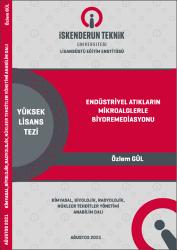| dc.contributor.advisor | Yola, Mehmet Lütfi | |
| dc.contributor.advisor | Kıran, Tuğba Raika | |
| dc.contributor.author | Gül, Özlem | |
| dc.date.accessioned | 2021-12-26T18:33:14Z | |
| dc.date.available | 2021-12-26T18:33:14Z | |
| dc.date.issued | 2021 | en_US |
| dc.date.submitted | 2021 | |
| dc.identifier.citation | Gul, O. (2021). Endüstriyel atıkların mikroalglerle biyoremediasyonu. (Yüksek Lisans Tezi). İskenderun Teknik Üniversitesi / Mühendislik ve Fen Bilimleri Enstitüsü, Hatay. | en_US |
| dc.identifier.uri | https://hdl.handle.net/20.500.12508/1974 | |
| dc.description.abstract | Tez çalışmasında, Kimyasal, Biyolojik, Radyolojik, Nükleer (KBRN) tehditlerinin toksik endüstriyel kimyasal sınıfında yer alan pestisitlerin mavi-yeşil mikroalg ile biyoremediasyon deneyleri yapılmış ve sonuçları analiz edilmiştir. Söz konusu pestisitler insan, canlı ve çevre sağlığına oldukça zararlı olmakla beraber doğada kalıcılığı yüksektir. Son zamanlarda tarımsal alanda pestisitlere olan talebin ve kullanımın artması üretim, taşıma ve depolama alanlarında risk oluşturmaktadır. Kullanmış olduğumuz mikroalgin hali hazırda başta tıp ve ilaç sanayisi olmak üzere önemli alanlarda kullanımının mevcut olmasının yanı sıra pestisitleri metabolize etme yeteneği bilinmektedir. Pestisitlerin zararlı etkilerini yok etmek ya da en aza indirgemek için biyoremediasyon yönteminin etkinliği çalışmamız ile desteklenmiştir. Çalışmada kullanılan mikroalg ve pestisitlerin daha önceki çalışmalarda kullanılmaması tez çalışmamızın özgünlüğünü kanıtlamaktadır. Deneysel çalışma sonucu elektrokimya yöntemi ile analizler yapılmış ve Spirulina platensis tarafından phosmet'in 7 gün sonunda %70,0, ethion'un % 61,0, methly parathion'un ise %50,0 oranında ortamdan uzaklaştırıldığı tespit edilmiştir. | en_US |
| dc.description.abstract | In thesis study, bioremediation experiments of pesticides in toxic industrial chemical class of Chemical, Biological, Radioactive, Nuclear (CBRN) threats were conducted with blue- green microalgae and their results were analysed. Though these aforementioned pesticides are highly harmful to human, living and environmental health, they have high-permanence in nature. Recently, the increasing demand and use of pesticides in agriculture poses risks in production, transportation and storage areas. The microalgae we have used is already known for its ability to metabolize pesticides, as well as being used in important areas, especially in the medicine and pharmaceutical industry. The effectiveness of the bioremediation method in order to eliminate or minimize the harmful effects of pesticides has been supported by our study. The fact that the microalgae and pesticides used in the study were not used in previous studies proves the originality of our thesis. As a consequence of the experimental study, analyses were made with electrochemistry method and at the end of 7 days it has been determined that phosmet is removed by spirulina platensis by 70.0%, ethion by 61.0% and methyl parathion by 50.0%. | en_US |
| dc.language.iso | tur | en_US |
| dc.publisher | İskenderun Teknik Üniversitesi / Mühendislik ve Fen Bilimleri Enstitüsü / Kimyasal, Biyolojik, Radyolojik, Nükleer Tehditler Yönetimi Ana Bilim Dalı | en_US |
| dc.rights | info:eu-repo/semantics/openAccess | en_US |
| dc.subject | KBRN | en_US |
| dc.subject | Pestisit | en_US |
| dc.subject | Biyoremediasyon | en_US |
| dc.subject | Mikroalg | en_US |
| dc.subject | CBRN | en_US |
| dc.subject | Pesticide | en_US |
| dc.subject | Bioremediation | en_US |
| dc.subject | Microalgae | en_US |
| dc.title | Endüstriyel atıkların mikroalglerle biyoremediasyonu | en_US |
| dc.title.alternative | Bioremediation of i̇ndustri̇al waste with microalgae | en_US |
| dc.type | masterThesis | en_US |
| dc.contributor.department | Mühendislik ve Doğa Bilimleri Fakültesi | en_US |
| dc.contributor.authorID | 0000-0001-7424-3425 | en_US |
| dc.relation.publicationcategory | Tez | en_US |
| dc.relation.index | İndeks Bilgisi Yok | en_US |
















